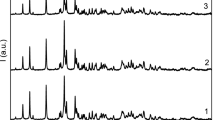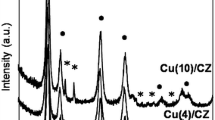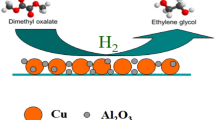Abstract
A catalyst precursor with highly developed specific surface area of 10 m2/g and a pore volume of 0.02 cm3/g is synthesized. The peculiarities of the system studied related to the structure of the copper oxalate, crystallizing as an anhydrous salt with “zeolitic type” bonded water, its content varying between 0 and 1, are pointed out. The thermal decomposition is followed by investigating the magnetic properties in situ. The results are complementary to the information obtained by DTA/TG studies. The performance of magnetic measurements and the calculation of the magnetic moment μeff in the range from –100 to 300∘C allow a conclusion to be drawn concerning the coordination of the Cu(II) ions and the change in the oxidation state. In the starting oxalate, Cu(II) is in a tetrahedral-like coordination, which is a result of the strong tetragonal deformation of the octahedral field and of the stronger tendency of the oxalate ion to rotate around the C–C bond axis. The dehydration process does not affect the XRD results, but changes the temperature dependence of μeff due to the change in the Cu(II) coordination. The μeff values during the decomposition process suggest that the proportion Cu(II)-Cu(I) could be varied in the final product by varying the temperature range. By isothermal annealing at 300∘C for 1 h, an oxide product containing Cu(II)-Cu(I) is synthesized and characterized. The solid phase products corresponding to the separate parts of the DTA/TG curves are: [Cu] → Cu + Cu2O (185–300∘C), 0.5Cu2O + 2CuO (300–345∘C), 3CuO (345–400∘C).
Similar content being viewed by others
References
L. MARTA, O. HOROWITZ and M. ZAHARESCU, Key Eng. Mat. 132–136 (1997) 1239.
G. E. SHTER and G. S. GRADER, J. Am. Ceram. Soc. 77 (1994) 1436.
K. BERNARD and G. GRITZNER, Phys. C., Supercond. 196(3/4) (1992) 259.
CONGKANG XU, YINGKAI LIU, GOUDING XU and GUANGHOU WANG, Mat. Res. Bull. 37 (2002) 2365.
M. POPA, J. M. CALDERON-MORENO, D. CRISAN and M. ZAHARESCU, J. Therm. Anal. Calorimetry 62 (2000) 633.
T. SPASOVA, M. KHRISTOVA, D. PANAYOTOV and D. MEHANDJIEV, J. Cat. 189 (1999) 43.
E. BEKYAROVA and D.MEHANDJIEV, in Proceedings of the 8th International Symposium on Heterogeneous Catalys (Varna, 1996) p. 787.
G. BLIZNAKOV, D. MEHANDJIEV and B. DYAKOVA, Kinet. Katal. 9 (1968) 269.
D. MEHANDJIEV and E. NICKOLOVA-ZHECHEVA, Thermoch. Acta 51 (1981) 343.
E. ZHECHEVA, S. ANGELOV and D. MEHANDJIEV, ibid. 67 (1983) 91.
A. M. DONIA, N. R. E. RADWAN and A. A. ATIA, J. Therm. Anal. Calorimetry 61 (2000) 249.
V. V. ZELENTZOV and T. G. AMINOV, Dokl. Akad. Nauk SSSR 158 (1964) 1393.
O. ASAI, M. KISHITA and M. KUBO, J. Phys. Chem. 63 (1959) 96.
L. DUBICKI, Inorg. Chem. 5 (1966) 93.
B. N. FIGGIS and D. J. MARTIN, ibid. 5 (1966) 100.
J. J. GIRERD, O. KAHN and M. VERDAGUER, ibid. 19 (1980) 274.
A. MICHALOWICZ, J. J. GIRERD and J. GOULON, ibid. 18 (1979) 3004.
A. GLEIZES F. MAURY and J. GALY, ibid. 19 (1980) 2074.
H. FICHTNER- SCHMITTLER, Crystal Res. Technol. 19 (1984) 1225.
H. SCHMITTLER, Monatsber. Deut. Acad. Wiss. Berlin 10 (1968) 581.
LE VAN MY, G. PERINET and P. BLANCO, Bull. Soc. Chim. France 361 (1969) 361.
K. P. PRIBYLOV and D. SH. FAZLULINA, Zh. Inorg. Khim. 14 (1969) 660.
K. NAGASE, K. SATO and N. TANAKA, Bull. Chem. Soc. Japan 48 (2) (1975) 439.
Y. A. UGAI, Zh. Obshch. Khim. 24 (1954) 1315.
R. PRASAD, Thermoch. Acta 406 (2003) 99.
D. BROADBENT, J. DOLLIMOR, D. DOLLIMOR and T. A. EVANS, J. Chem. Soc. Faraday Trans. 87(1) (1991) 161.
P. PESHEV, G. GYUROV, Y. KHRISTOVA, K. PETROV, D. KOVACHVO, Y. DIMITRIEV, N. NENCHEVA and E. EVLAKHOR, Mater. Res. Bull. 23 (1988) 1765.
D. DOLLIMORE, Thermoch. Acta 177 (1991) 59.
Idem., ibid. 117 (1987) 331.
V. V. BOLDYREV, I. S. NEVANCHEV, JU. I. MIHAYLOV and E. F. HAYRETDINOV, Kinet. Katal. 11 (1970) 367.
M. E. BROWN, D. DOLLIMORE and A. K. GALWEY, in “Comprehensive Kinetics, Reactions in the Solid State,” edited by C.H. Bamford and C. F. H. Tipper (Elsevier, Amsterdam 1980) Vol. 22, p. 218.
H. J. T. ELLINGHAM, J. Soc. Chem. Ind., (London) 63 (1944) 125.
N. J. CARR and A. K. GALWEY, J. Chem. Soc. Faraday Trans 1 84(5) (1988) 1357.
F. E. MABBS and D. J. MACHIN, in “Magnetism and Transition Metal Complexes” (Chapman & Hall, London, 1973) p. 153.
D. MEHANDJIEV and S. ANGELOV, in “Magnetochemistry of Solid State” (Nauka I Izkustvo, Sofia, 1979) p.116.
R. BOCA, in “Theoretical Foundations of Molecular Magnetism” (Elsevier, Amsterdam, Lousanne, New Yok, Oxford, Shannon, Singapore, Tokyo, 1999) p. 504.
UPAC (Fiz.Chem.Division), Recomandation 1984, Pure Appl. Chem. 57 (1985) 603.
T. TSONCHEVA, S. VANKOVA and D. MEHANDJIEV, Fuel’82(2003) 755.
V. RAKIC, V. DONDUR, S. GAJINOV and A. AUROUX, Thermoch. Acta 420 (2004) 51.
Author information
Authors and Affiliations
Corresponding author
Rights and permissions
About this article
Cite this article
Donkova, B., Mehandjiev, D. Review Thermal—magnetic investigation of the decomposition of copper oxalate—a precursor for catalysts. J Mater Sci 40, 3881–3886 (2005). https://doi.org/10.1007/s10853-005-0487-0
Received:
Accepted:
Issue Date:
DOI: https://doi.org/10.1007/s10853-005-0487-0




